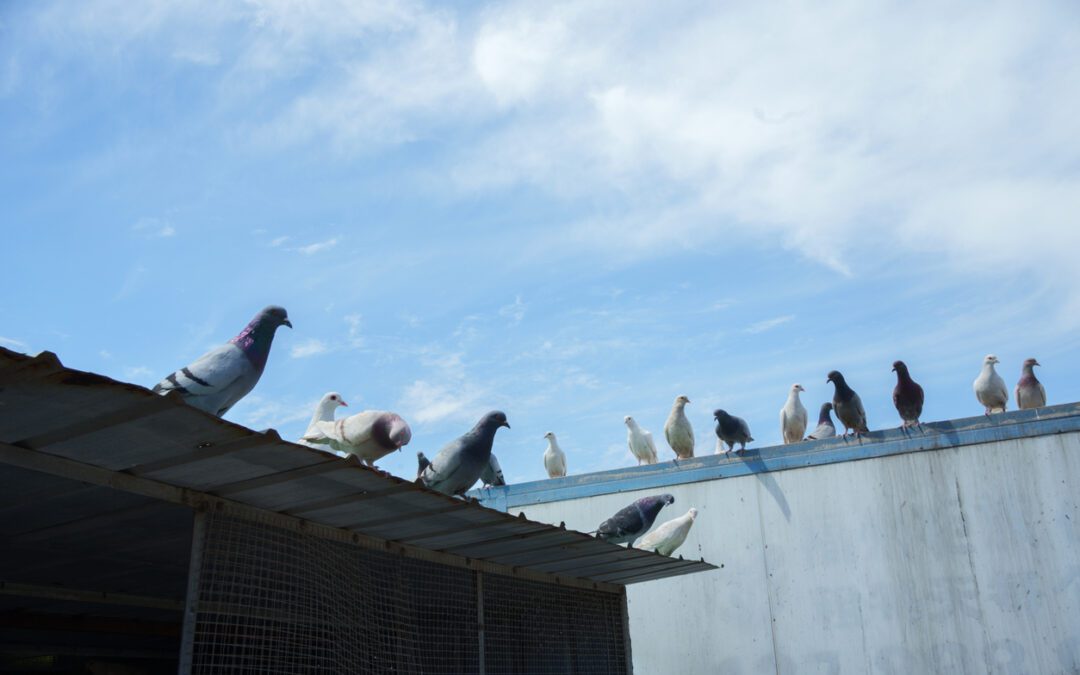
by Pigeon Patrol | Jul 9, 2024 | Bird Netting
Rock pigeons should not be overlooked. Here’s why
I headed out to Wells Harbor this weekend to see what birds were there: Who was back from the south, who was migrating through and whether anyone was changing plumage as their mating season ramps up?
Instead, I was completely distracted (in a good way) by some common pigeons. They were all over the dock: cooing, strutting around, flying from one perch to another. There were pale gray ones, dark ones, and checkered ones. I had been thinking about seasonal plumage changes.
Rock pigeon with checkered plumage at Wells Harbor in Maine Sunday, March 31, 2024.
For example, just this weekend brilliant yellow male goldfinches showed up at my feeders. They’ve been coming all winter wearing their winter drab colors, now that it is time to mate, the males are getting all fancy. The loons at the harbor were also showing signs of change, transitioning from subdued, faded blacks and whites of winter to their summer colors — striking black and white spotted backs with contrasting white breast. What was up with the pigeons? Were some in breeding plumage? Is there a difference between male and females? Were the dark ones juveniles, as is common with some of the local gulls?
A natural adult rock pigeon at Wells Harbor in Maine Sunday, March 31, 2024.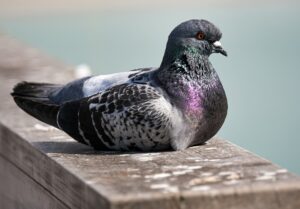
I’ve tended to write pigeons off when I go birding. After all, they are an introduced species, the descendants of domestic pigeons brought over from Europe back in the 1600s. Rock pigeons (Columba livia) are thought to be one of the first domesticated birds, raised for both their meat and their message-carrying ability. According to the Cornell Lab of Ornithology “Mesopotamian cuneiform tablets and Egyptian hieroglyphics suggest that pigeons were domesticated more than 5,000 years ago. In fact, these birds have such a long history with humans that it’s impossible to tell where the species’ original range was.” Those domesticated pigeons were carried everywhere that humans went, and many escaped, establishing feral populations on every continent except Antarctica.
Aan adult dark rock pigeon at Wells Harbor in Maine Sunday, March 31, 2024.
Spring was definitely in the air at the harbor. Rock pigeons have been known to raise over six broods per year (these are serious breeders!) so I imagine these pigeons were in the throes of mating season. Some of the pigeons were puffing themselves up and strutting around in circles. These were presumably males-displaying to court females: standing tall, inflating their crops, fanning their tails, and strutting in a circle around the female while cooing in their most alluring manner. This will progress to mutual preening (referred to as nibbling) followed by the male regurgitating some seeds or liquid and feeding the female, one of the final behaviors prior to mating. While rock pigeons are monogamous and mate for life, I think of these displays as our date nights (minus the regurgitation). As with long-married couples, these displays strengthen their bond and indicate readiness to mate.
A rock pigeon strutting over to its mate at Wells Harbor in Maine Sunday, March 31, 2024.
It makes sense that they are nesting at the harbor. In the wild they nest on cliffs (hence the name rock pigeon). In cities and towns they prefer window ledges, traffic lights, roofs and under bridges. We don’t have skyscrapers, but we do have docks and rocky outcroppings.
Pigeons do so well around humans because they are prolific breeders, we build structures that they like to nest on, and they like the food that we grow-they like all sorts of seed crops and, of course, they like breadcrumbs. They are also unbelievable navigators and flyers (one reason they made great messenger birds). Even blindfolded, pigeons can find their way home by sensing the Earth’s magnetic field. They might also use sound, and smell-this is currently being investigated. Without a blindfold they can also use cues based upon the position of the sun (allaboutbirds.com/Rock_Pigeon). They can maintain speeds of 40 mph or more for long periods of time (another reason they made great messenger birds). Rock pigeons are also acrobatic flyers-watch them zoom around a city park, or effortlessly fly between the pilings under a dock-these birds can give most predators a run for their money.
An adult dark rock pigeon at Wells Harbor in Maine Sunday, March 31, 2024.
Those color variations that first caught my eye are just color variations. Pigeons come in a variety of plumages that have nothing to do with gender or age (but probably something to do with the breeding of domesticated birds), so looking for mating displays this time of year is the best way to distinguish males from females. Now that I know more about them, next time I am out birding I’m definitely going to pay more attention to the pigeons.
Susan Pike, a researcher and an environmental sciences and biology teacher at Dover High School, welcomes your ideas for future column topics. Send your photos and observations to spike3116@gmail.com. Read more of her Nature News columns at Seacoastonline.com and pikes-hikes.com, and follow her on Instagram @pikeshikes.
Pigeon Patrol
Pigeon Patrol Products & Services is the leading manufacturer and distributor of bird deterrent (control) products in Canada. Pigeon Patrol products have solved pest bird problems in industrial, commercial, and residential settings since 2000, by using safe and humane bird deterrents with only bird and animal friendly solutions. At Pigeon Patrol, we manufacture and offer a variety of bird deterrents, ranging from Ultra-flex Bird Spikes with UV protection, Bird Netting, 4-S Bird Gel and the best Ultrasonic and audible sound devices on the market today.
Canada’s top wholesaler for bird deterrent products for twelve consecutive years.
Contact us at 1- 877– 4– NO-BIRD, (604) 585-9279 or visit our website at https://www.pigeonpatrol.ca/
Bird Gone, Pigeon Gone, Pigeon problems, pigeon spikes, 1-877-4NO-BIRD, 4-S Gel, Bird Control, Pigeon Control, bird repellent, Bird Spikes, sonic bird repellent, stainless steel bird spikes, bird spikes Vancouver, Ultra Sonic Bird Control, Bird Netting, Plastic Bird Spikes, Canada bird spike deterrents, Pigeon Pests, B Gone Pigeon, Pigeon Patrol, pest controller, pest control operator, pest control technician, Pigeon Control Products, humane pigeon spikes, pigeon deterrents, pigeon traps, Pigeon repellents, Sound & Laser Deterrents, wildlife control, raccoon, skunk, squirrel deterrent, De-Fence Spikes, Dragons Den, Pigeon, Pigeon Patrol, Pigeons Roosting, Vancouver Pigeon Control, Bird Spikes, Bird Control, Bird Deterrent, Pigeon Deterrent, Surrey Pigeon Control, Pest, Seagull deterrent Vancouver Pigeon Blog, Birds Inside Home De-fence, Pigeon Nesting, Bird Droppings, Pigeon Dropping, woodpecker control, Keep The Birds Away, Birds/rats, seagull, pigeon, woodpecker, dove, sparrow, pidgeon control, pidgeon problem, pidgeon control, flying rats, pigeon Problems, bird netting, bird gel, bird spray, bird nails, bird guard, Pigeon control, Bird deterrents, Pigeon deterrents, Bird control, solutions, Pigeon prevention, Pigeon repellent, Bird proofing, Pest bird management, Pigeon spikes, Bird netting, Humane bird control, Bird exclusion, Urban bird control, Anti-roosting devices, Pigeon removal, Bird barriers
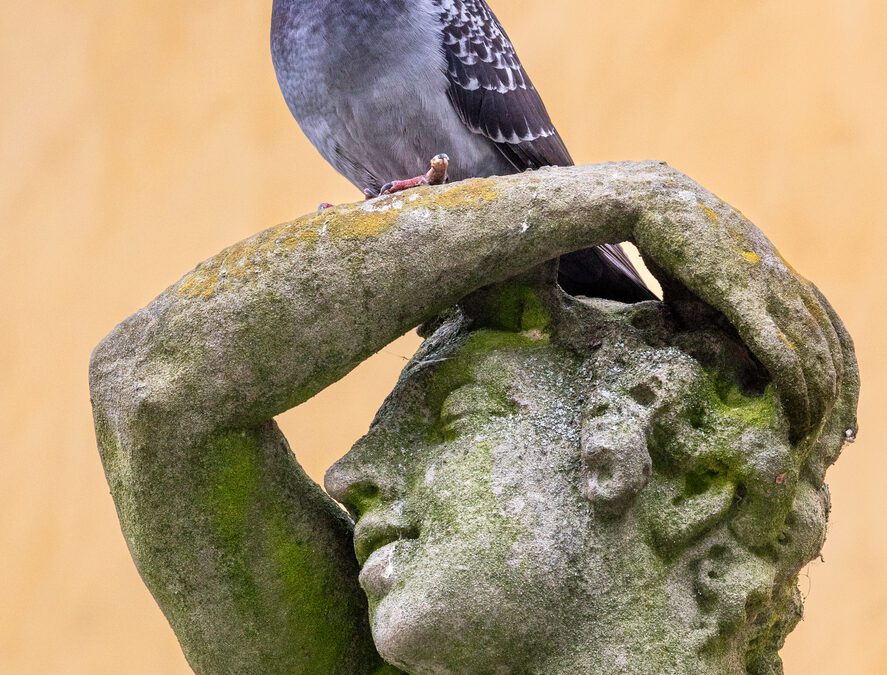
by Pigeon Patrol | Jul 9, 2024 | Bird Netting
Meet the N.L. couple finding happiness in pet pigeons
Pet pigeons may be unconventional, but there’s room for love and acceptance
Whether wandering around the Avalon Mall or walking along the harbour during cruise ship season, partners Matthew and Jay Howlett regularly draw curious glances from passersby.
Proudly perched on either of their shoulders is a pigeon wearing pants, and chances are his name is Mr. Earl Grey.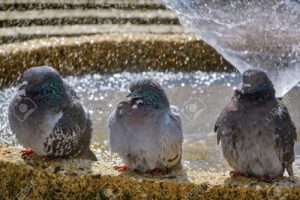
“We get stopped every two seconds,” said Jay Howlett. “[People ask] ‘Is that real?’ Of course he’s real. He’s a gentleman. Look at him.”
Matthew and Jay Howlett are pigeon fanciers who take care of injured and rehabilitated pigeons that need some tender, loving care. Alongside their four pigeons and two diamond doves, the Howletts’ St. John’s apartment is also home to a corn snake, a pumpkin patch tarantula, an African fat tail gecko and a Syrian hamster.
Tiny pants, big hearts: why pigeons make the perfect pets for this St. John’s couple
Jay and Matthew Howlett were already into exotic pets when they discovered the colourful world of pigeon fanciers. The couple began taking in injured birds as pets, and now their apartment is home to a handful of pigeons with big personalities.
Their journey with the small-billed birds began in 2021 when Jay’s friend in Australia showed them their own flock via video calls. Surprised by the notion of pigeon ownership, Jay started researching to find out more about the world of the feathered creatures. What soon followed was a deeper understanding of where the birds — often seen pecking at the ground, eating grit and sand — came from and of their untold stories.
“It turns out that we’ve had them for about 8,000 to 10,000 years in worldwide history. Like, they’ve been with people that long. We’ve had them in World War I and World War II, so they’re veterans. A lot of people own them for racing, which personally I don’t condone. I do find it [to be] cruelty,” said Jay Howlett.
“But the coolest thing in history that I found was that they just co-existed with us. We use their eggs. We use their poop for fertilizer. Unfortunately, they’re on our city streets because of us.”
A man in a beanie stands indoors in a mall with a pigeon on a leash and in a diaper on his shoulder
According to the Howletts, cats and dogs may be mainstream pets, but keeping pigeons can open up a new companionship experience. (Nabila Qureshi/CBC)
Welcome to the family
With a newfound appreciation for pigeons, Jay Howlett reached out to fellow enthusiasts on a pan-Canadian group on Facebook, stating that they were looking to keep a pigeon as a pet.
“W found a really nice fella out in Witless Bay,” he said. “And he was basically like, ‘Pick one, pick two. How many do you want?’ And we end up going with two.”
Named Chai and Mr. Earl Grey, the pigeons took a few months to adjust to their new surroundings and human family. Gradually, their distinct personalities began to shine through.
“Earl Grey is a very dapper, loud gentleman. He loves to strut around the house and hoard all of my yarn. Chai is Earl’s flockmate. He is a little bit more timid and likes to keep to himself. He loves nesting, pretending he has an egg and sitting on it. The egg is a round chapstick,” Jay Howlett said.
A gray pigeon with its eyes closed is wrapped in a blanket. Its eyes are closed.
Waffles rests in a blanket on her first night of being rescued by the Howletts. (Submitted by Jay Howlett)
In 2022, a tip-off from a friend about a starving pigeon outside a convenience shop near Memorial University spurred the Howletts into action beyond mere pet ownership. They brought the bird home, affectionately naming her Waffles.
“We made her very comfortable. We tried our best to make sure that she was hydrated more than anything. We thought she was on the mend, but the stress from being starved and neglected for so long outside in the cold. She ended up having a stroke and she passed away while I was at work,” Jay Howlett said.
Moved by their experience with Waffles, the Howletts devoted themselves to opening up their hearts and home to even more pigeons in need. Along came Peaches, a white homing pigeon found at Bowring Park, and Chilli, whose hunched wings looked like a heavy ash-grey cloak.
“We found him over the summer at Kenny’s Pond and we were just feeding the pigeons like we normally do, and I saw a pigeon that was kind of limping but couldn’t fly,” said Jay Howlett.
“So I picked him up. His wing was broken but already fused in two places and his toe was backwards, so I decided to take him home.”
a man and a woman sit at table, drawing and playing a video game with a pigeon sitting on the man’s shoulder
Jay and Matthew Howlett’s day-to-day life centres on their pigeons and other small pets. (Zach Goudie/CBC )
The Howletts sought care from the Rock Wildlife Rescue, a rehabilitation centre in Torbay. Due to the nature of his injuries, Chilli’s wings had to be clipped, rendering him unable to fly ever again.
“He’s a strong bird. He was our latest one and he’s doing fantastic. He just has a big fear of people. But he knows lately he’s starting to come around and understand that we’ve helped him,” said Jay Howlett.
Matthew Howlett said another pigeon was attacked by a hawk.
“Parts of his body were actually missing,” he said, adding that the operator of the rescue group said that since they found him and got him the proper care, there’s a higher chance that he’s going to live.
Learning to build loving, ‘coo’-operative relationships
When asked why they bring their pigeons outdoors, on a leash, in pigeon pants that act and look like a diaper, their answer is education and awareness.
“We want to be a soft rescue. That’s our goal. We want to be somebody who takes in pigeons from the Rock Wildlife that can’t be re-released and give them proper homes because they deserve it,” said Jay Howlett.
a grey pigeon stands on the edge of a sofa. Its right wing droops low.
While Chilli may be flightless due to injury, he soars to new heights when he’s out and about on the Howletts’ shoulders. (Nabila Qureshi/CBC )
By expanding their haven for the birds, the Howletts also hope to play an important role in addressing overbreeding or abuse toward pigeons.
Ultimately, their message is to keep an eye out for any pigeon showing signs of disorientation, injury or panic from being near animals of prey like feral cats and hawks, and to bring them in for care at the Rock Wildlife Rescue.
“[The] least we can do is throw out a couple of seeds for them — not bread — and then just be nice to them,” said Jay Howlett. “They are just as cold as you are in the winter time, [and] as hot as you are in the summertime.”
Pigeon Patrol
Pigeon Patrol Products & Services is the leading manufacturer and distributor of bird deterrent (control) products in Canada. Pigeon Patrol products have solved pest bird problems in industrial, commercial, and residential settings since 2000, by using safe and humane bird deterrents with only bird and animal friendly solutions. At Pigeon Patrol, we manufacture and offer a variety of bird deterrents, ranging from Ultra-flex Bird Spikes with UV protection, Bird Netting, 4-S Bird Gel and the best Ultrasonic and audible sound devices on the market today.
Canada’s top wholesaler for bird deterrent products for twelve consecutive years.
Contact us at 1- 877– 4– NO-BIRD, (604) 585-9279 or visit our website at https://www.pigeonpatrol.ca/
Bird Gone, Pigeon Gone, Pigeon problems, pigeon spikes, 1-877-4NO-BIRD, 4-S Gel, Bird Control, Pigeon Control, bird repellent, Bird Spikes, sonic bird repellent, stainless steel bird spikes, bird spikes Vancouver, Ultra Sonic Bird Control, Bird Netting, Plastic Bird Spikes, Canada bird spike deterrents, Pigeon Pests, B Gone Pigeon, Pigeon Patrol, pest controller, pest control operator, pest control technician, Pigeon Control Products, humane pigeon spikes, pigeon deterrents, pigeon traps, Pigeon repellents, Sound & Laser Deterrents, wildlife control, raccoon, skunk, squirrel deterrent, De-Fence Spikes, Dragons Den, Pigeon, Pigeon Patrol, Pigeons Roosting, Vancouver Pigeon Control, Bird Spikes, Bird Control, Bird Deterrent, Pigeon Deterrent, Surrey Pigeon Control, Pest, Seagull deterrent Vancouver Pigeon Blog, Birds Inside Home De-fence, Pigeon Nesting, Bird Droppings, Pigeon Dropping, woodpecker control, Keep The Birds Away, Birds/rats, seagull, pigeon, woodpecker, dove, sparrow, pidgeon control, pidgeon problem, pidgeon control, flying rats, pigeon Problems, bird netting, bird gel, bird spray, bird nails, bird guard, Pigeon control, Bird deterrents, Pigeon deterrents, Bird control, solutions, Pigeon prevention, Pigeon repellent, Bird proofing, Pest bird management, Pigeon spikes, Bird netting, Humane bird control, Bird exclusion, Urban bird control, Anti-roosting devices, Pigeon removal, Bird barriers
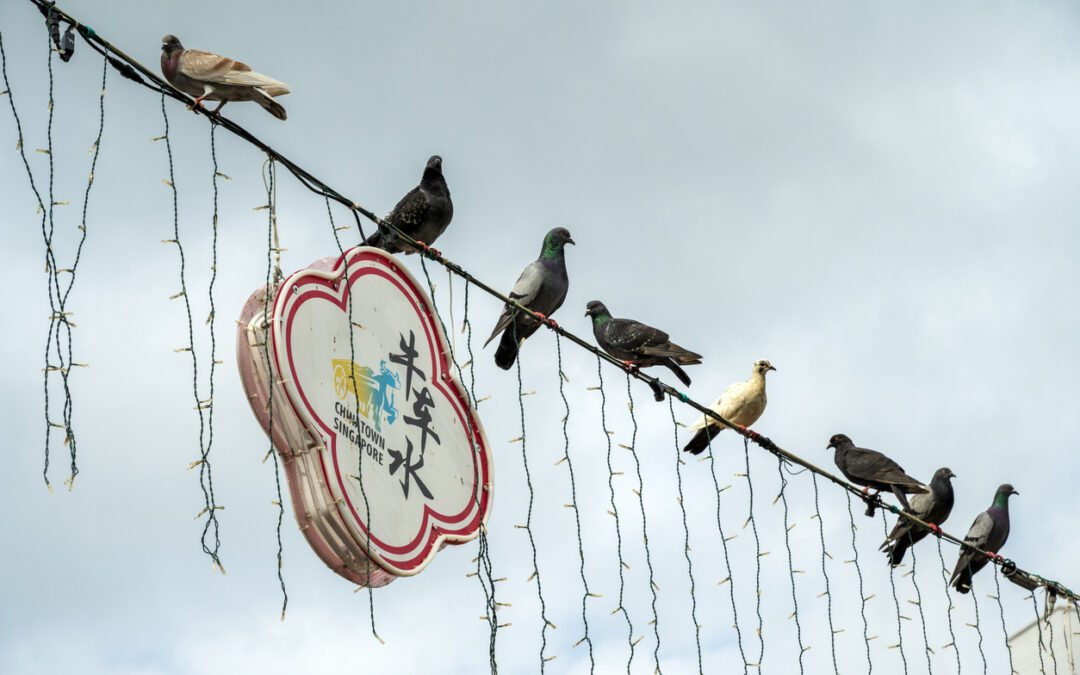
by Pigeon Patrol | Jul 9, 2024 | Bird Netting
Many Toronto residents won’t be taking anymore crap — from pigeons.
“I live here, right across the street, and the pigeons are a nuisance,” said Richard Evans, as he pointed to a condo building at Yonge and Finch.
“They line up on this wire here across Yonge Street, hundreds of them. They have a habit of going to the bathroom on the road and on cars.”
Evans says he hasn’t been ‘lucky enough’ to be used as turd target by pigeons before, but that he hears a lot of concerns from those with balconies on their condos.
These concerns have been heard loud and clear by Esther Attard.
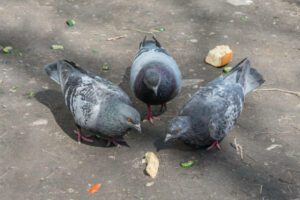
Two gray pigeons eat a piece of bread on the ground, the third is watching them
“(Residents) can’t use their outdoor space, well, because of excrement,” said the chief veterinarian and director of animal services for the City of Toronto.
“It can be a public health risk, but that is a low risk. We haven’t had any of these issues.”
In its quest to find solutions, Attard says a humane option stood out: putting pigeons on the pill.
Ovocontrol, produced by Innolytics LLC, is a contraceptive for pigeons that is made into wheat-flour kibble.
Dubbed ‘planned pigeonhood’, the kibble is put into a timed, automatic feeder and placed on several rooftops in urban areas.
The pigeon contraceptive is manufactured into a form of kibble made of wheat flour. via Innolytics LLC
Motion-sensing cameras nearby capture the pigeons, or any other creature, that approaches the bait.
In May 2022, the city decided to launch a pilot of the pigeon contraceptive, which Attard says officially got working in May 2023.
For the cost of $24,000 a year, the feeders were placed at three wards: University-Rosedale (includes two sites), Beaches-East York, and Don Valley North.
The daily email you need for Okanagan’s top news stories.
A fifth ward — Spadina-Fort York — is expected to be added to the pilot later this month, for an additional $6,000 per year.
An automatic feeder dispenses the contraceptive once every morning, timed by seconds based on the number of pigeons. via Innolytics LLC
“I’m kind of shocked,” Jenn, who loves pigeons, told Global News Toronto.
“I feel like it could be a way to control the reproduction of pigeons. But is it the most ethical?” she added.
“As long as it’s ethical, I guess it’s fine. There’s a lot of pigeons around the area,” said Jane, who works around the Yonge and Finch area.
The pill works by allowing pigeons to still lay eggs that aren’t fertilized. The eggs won’t hatch because there is no embryo inside.
The CEO of the company behind Ovocontrol said the product is far more humane than other tactics used in Toronto, like poison and lethal traps.
“This contraceptive is effective in species that have feathers and lay eggs. so there’s no risk to your pets, your children,” said Erick Wolf.
When asked how he can be sure that the pill isn’t eaten by other birds, Wolf said the larger size of the kibble, and the high location of the feeders, attract only pigeons.
“Smaller birds usually feed from the tree canopy and below,” he said.
The effects of the pill also cannot be transferred to birds of prey, like owls, that eat the pigeons.
The contraceptive works if pigeons ingest it daily. If they stop, Wolf said, they can reproduce normally again.
Attard also noted that, similar to the birth control pill for humans, missing one day won’t make a big difference.
She says the program has already showed some signs of success, because there’s been fewer birds observed on webcam.
But it’s still hard to be sure, so she’s hoping there will be a clearer picture by the spring or summer of this year.
Four locations, in three Toronto wards, already have the feeders installed. A fourth ward -Spadina Fort York – will be added later this month. Global News Toronto
However, the idea has already taken flight with some.
“I am advocating vigorously for it to come to my ward,” Lily Cheng, Willowdale councillor, told Global News.
“For residents who live in condos, their balcony is a really precious outdoor space for them. Unfortunately due to the pigeon problem, many residents are unable to use their outdoor space … it can also be really stressful when crossing the street ”
Evans knows that stress all too well.
Upon learning about the program, he said he’s glad to hear there’s a solution to the poopy problem that doesn’t seem to harm pigeons.
“If it seems to be working, then why not?”
Pigeon Patrol
Pigeon Patrol Products & Services is the leading manufacturer and distributor of bird deterrent (control) products in Canada. Pigeon Patrol products have solved pest bird problems in industrial, commercial, and residential settings since 2000, by using safe and humane bird deterrents with only bird and animal friendly solutions. At Pigeon Patrol, we manufacture and offer a variety of bird deterrents, ranging from Ultra-flex Bird Spikes with UV protection, Bird Netting, 4-S Bird Gel and the best Ultrasonic and audible sound devices on the market today.
Canada’s top wholesaler for bird deterrent products for twelve consecutive years.
Contact us at 1- 877– 4– NO-BIRD, (604) 585-9279 or visit our website at https://www.pigeonpatrol.ca/
Bird Gone, Pigeon Gone, Pigeon problems, pigeon spikes, 1-877-4NO-BIRD, 4-S Gel, Bird Control, Pigeon Control, bird repellent, Bird Spikes, sonic bird repellent, stainless steel bird spikes, bird spikes Vancouver, Ultra Sonic Bird Control, Bird Netting, Plastic Bird Spikes, Canada bird spike deterrents, Pigeon Pests, B Gone Pigeon, Pigeon Patrol, pest controller, pest control operator, pest control technician, Pigeon Control Products, humane pigeon spikes, pigeon deterrents, pigeon traps, Pigeon repellents, Sound & Laser Deterrents, wildlife control, raccoon, skunk, squirrel deterrent, De-Fence Spikes, Dragons Den, Pigeon, Pigeon Patrol, Pigeons Roosting, Vancouver Pigeon Control, Bird Spikes, Bird Control, Bird Deterrent, Pigeon Deterrent, Surrey Pigeon Control, Pest, Seagull deterrent Vancouver Pigeon Blog, Birds Inside Home De-fence, Pigeon Nesting, Bird Droppings, Pigeon Dropping, woodpecker control, Keep The Birds Away, Birds/rats, seagull, pigeon, woodpecker, dove, sparrow, pidgeon control, pidgeon problem, pidgeon control, flying rats, pigeon Problems, bird netting, bird gel, bird spray, bird nails, bird guard, Pigeon control, Bird deterrents, Pigeon deterrents, Bird control, solutions, Pigeon prevention, Pigeon repellent, Bird proofing, Pest bird management, Pigeon spikes, Bird netting, Humane bird control, Bird exclusion, Urban bird control, Anti-roosting devices, Pigeon removal, Bird barriers
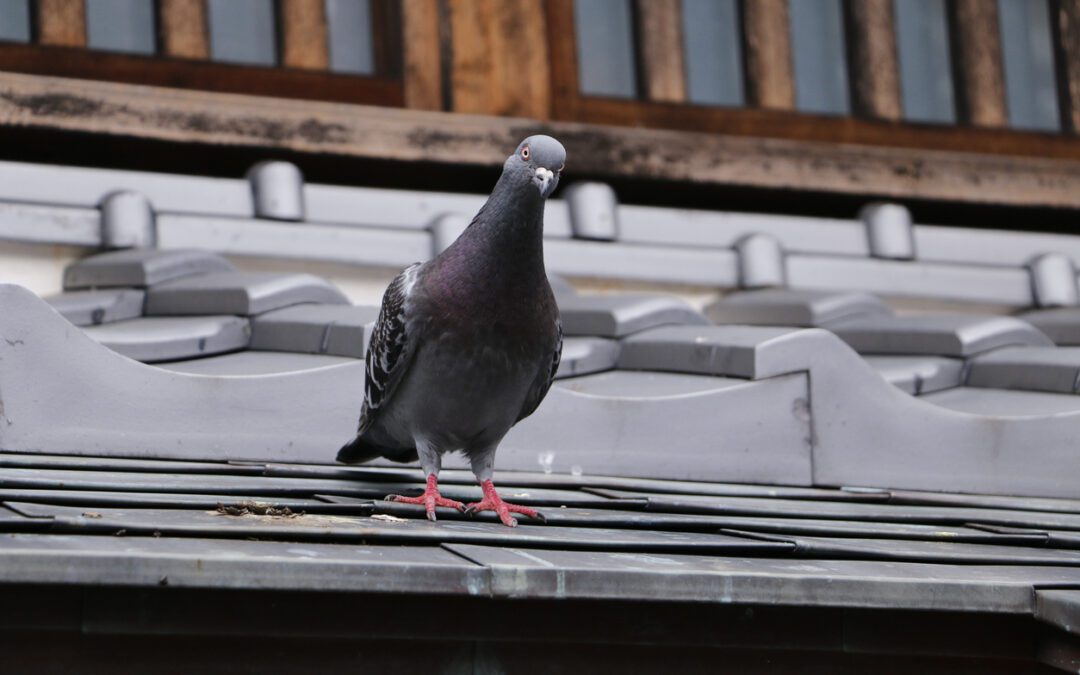
by Pigeon Patrol | Jul 9, 2024 | Bird Netting
Feeding pigeons is illegal in Toronto but some residents are doing it anyway
Many Torontonians are enjoying feeding and playing with pigeons despite it being technically illegal.
Pigeon breeding just started last month, so pedestrians are seeing groups of these birds flocking on city streets.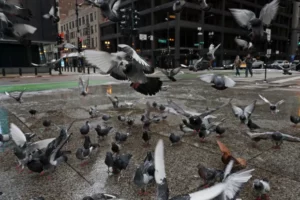
Although some Torontonians on social media are frustrated about Toronto’s growing pigeon population, others are sharing their new fondness for pigeons on TikTok.
‘Toronto Gone Wild,’ new exhibit explores the city’s ever-evolving relationship with wildlife
TikToker @stav.t posted a video two days ago of a man at Yonge and Dundas Square gracefully feeding pigeons from the palm of his hand.
The man then walks up to the TikToker’s brother who also holds out his hand to hold a bird while grinning.
Another TikToker posted a video a month ago of a man with a pigeon perched on his shoulder.
The man lets the pigeon rest on him as he pushes it up for lift off, but it continues to return to his shoulder.
And Toronto TikToker @jennamakesvideos posted a series of videos last year kneeling on the sidewalk to feed the flocks of pigeons around her.
Unfortunately, Toronto’s Animals Bylaw prohibits anyone from feeding any wildlife or leaving food out to attract animals both on public and private property unless an individual has a bird feeder and the domestic birds are under their care.
Some Torontonians love pigeons so much that they raise them to enter them in races.
Toronto is home to Pioneer Racing Pigeon Club, GTA Pigeon Club Canada, Brampton Pigeon Club, and Pakistan Pigeon Club of Canada.
Breeding pigeons for racing is perfectly safe as long as breeders follow their city’s guidelines, according to the Canadian Racing Pigeon Union.
Toronto officials say residents can keep up to 30 domestic pigeons and up to 50 during the breeding season between April and October.
Pigeon Patrol
Pigeon Patrol Products & Services is the leading manufacturer and distributor of bird deterrent (control) products in Canada. Pigeon Patrol products have solved pest bird problems in industrial, commercial, and residential settings since 2000, by using safe and humane bird deterrents with only bird and animal friendly solutions. At Pigeon Patrol, we manufacture and offer a variety of bird deterrents, ranging from Ultra-flex Bird Spikes with UV protection, Bird Netting, 4-S Bird Gel and the best Ultrasonic and audible sound devices on the market today.
Canada’s top wholesaler for bird deterrent products for twelve consecutive years.
Contact us at 1- 877– 4– NO-BIRD, (604) 585-9279 or visit our website at https://www.pigeonpatrol.ca/
Bird Gone, Pigeon Gone, Pigeon problems, pigeon spikes, 1-877-4NO-BIRD, 4-S Gel, Bird Control, Pigeon Control, bird repellent, Bird Spikes, sonic bird repellent, stainless steel bird spikes, bird spikes Vancouver, Ultra Sonic Bird Control, Bird Netting, Plastic Bird Spikes, Canada bird spike deterrents, Pigeon Pests, B Gone Pigeon, Pigeon Patrol, pest controller, pest control operator, pest control technician, Pigeon Control Products, humane pigeon spikes, pigeon deterrents, pigeon traps, Pigeon repellents, Sound & Laser Deterrents, wildlife control, raccoon, skunk, squirrel deterrent, De-Fence Spikes, Dragons Den, Pigeon, Pigeon Patrol, Pigeons Roosting, Vancouver Pigeon Control, Bird Spikes, Bird Control, Bird Deterrent, Pigeon Deterrent, Surrey Pigeon Control, Pest, Seagull deterrent Vancouver Pigeon Blog, Birds Inside Home De-fence, Pigeon Nesting, Bird Droppings, Pigeon Dropping, woodpecker control, Keep The Birds Away, Birds/rats, seagull, pigeon, woodpecker, dove, sparrow, pidgeon control, pidgeon problem, pidgeon control, flying rats, pigeon Problems, bird netting, bird gel, bird spray, bird nails, bird guard, Pigeon control, Bird deterrents, Pigeon deterrents, Bird control, solutions, Pigeon prevention, Pigeon repellent, Bird proofing, Pest bird management, Pigeon spikes, Bird netting, Humane bird control, Bird exclusion, Urban bird control, Anti-roosting devices, Pigeon removal, Bird barriers
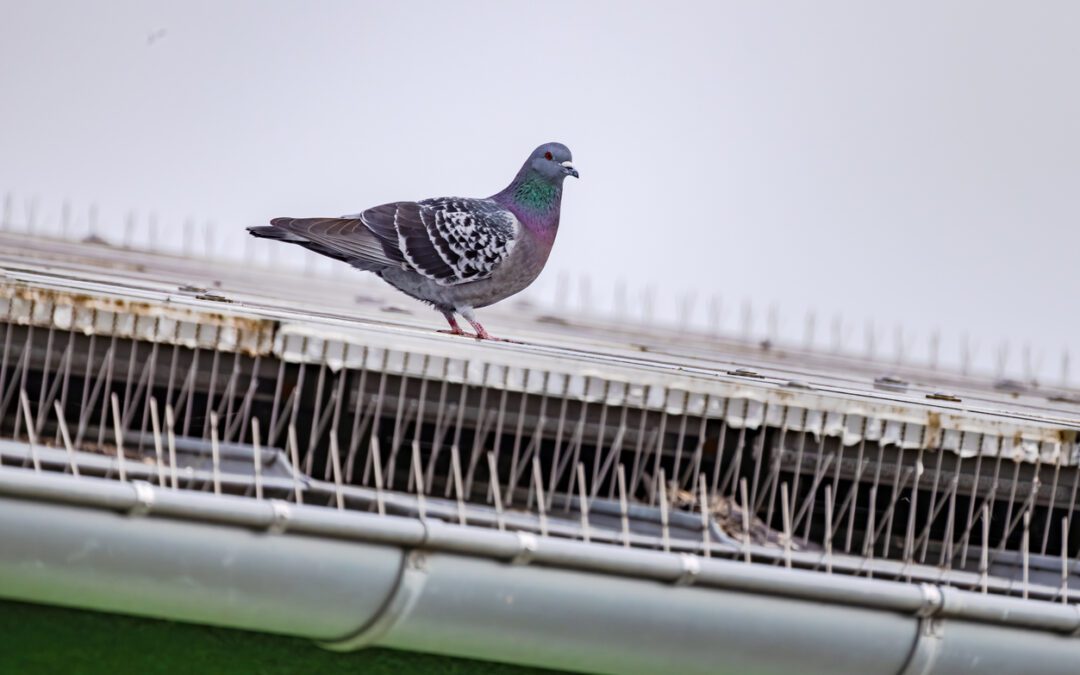
by Pigeon Patrol | Jul 9, 2024 | Bird Netting
Mumbai doctors blame pigeons for spike in lung disease
Doctors treating 5 times more cases of severe lung inflammation called hypersensitivity pneumonitis
Salimah Shivji · CBC News · Posted: Dec 27, 2023 1:00 AM PST | Last Updated: December 27, 2023
A pigeon looks off into the distance in Mumbai, India.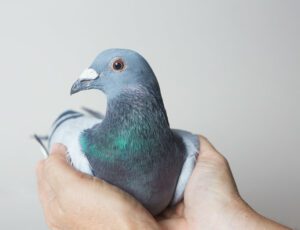
Mumbai’s pigeon population has exploded in recent years and the city’s doctors point to that rise as the reason behind a fivefold increase in cases of hypersensitivity pneumonitis, a severe inflammation of the lungs. (
“Are you around pigeons often? What else are you exposed to?”
The pulmonologist is part of a group of doctors working in India’s most populous city who are increasingly alarmed over what they’ve observed over the past seven years: a fivefold increase in cases of a severe inflammation of the lungs called hypersensitivity pneumonitis.
It’s a steep spike that experts link directly to Mumbai’s exploding pigeon population. The bird’s droppings contain fungi that, if inhaled over a sustained period, can cause the immune system disorder.
“It’s a terrible, progressive condition,” said Dr. Prabhudesai in an interview with CBC News, adding that in chronic cases, hypersensitivity pneumonitis causes irreversible scarring to the lungs, which can require the patient to be on a constant supply of oxygen, or even lead to a lung transplant.
“There are more than 300 reasons to get this hypersensitivity pneumonia and [exposure to] pigeons is one of them,” Prabhudesai said. “Most importantly, this is the most common cause of the disease in our country.”
A doctor speaks to his colleague about patient’s lung condition diagnosis at a clinic in Mumbai, India.
Pulmonologist Dr. Prahlad Prabhudesai, who’s seeing more cases of lung disease hypersensitivity pneumonitis caused by exposure to pigeon droppings, often tells patients to not feed birds. (Salimah Shivji/CBC)
Other causes are allergens found in grains, feathers and air conditioning units that aren’t properly maintained, but several recent studies monitoring newly-diagnosed patients in India identified exposure to birds as the leading link to the chronic disease.
Experts are calling for further data to be collected and the Indian Council of Medical Research has now developed a registry to track cases of the lung disease, along with the identified causes.
Problem with feeding pigeons
The problem is acute in Mumbai, India’s most densely-populated city that has millions of apartment buildings with flat surfaces where pigeons love to roost. The city also has a robust cultural tradition of feeding the birds for religious reasons, such as a deep-seated belief that caring for pigeons brings blessings and will help wash away a person’s sins.
Mumbai is known for its kabutarkhanas, designated feeding parks often located near temples and other places of worship where thousands of pigeons gather and are fed. It’s not uncommon to see people dragging large bags of grain to pour in front of the birds.
“In Mumbai, a lot of feeding is being done near your house, near temple…everywhere you go,” Prabhudesai said.
He often fields questions from patients asking if there is a pigeon repellent or other technology being developed to drive the birds away from homes.
group of pigeons in central Mumbai, India.
Pigeon droppings contain fungi that can cause a severe inflammation of the lungs after prolonged exposure. (Glen Kugelstadt/CBC)
‘I had no idea’
“Patient awareness [of the danger of pigeons] has started to increase over the past five years,” he said, but many of them feel helpless “because they are very stubborn birds.”
A hypersensitivity pneumonitis diagnosis came completely out of the blue for Namrata Trivedi, who just returned to work in the past year after more than a decade of battling the disease.
She began experiencing breathing problems and a persistent dry cough in 2011 and a string of doctors couldn’t figure out what she had.
“When I saw the X-ray from my CT scan, I could see a black layer all over my lungs,” she told CBC News in an interview in Gujarati.
“The doctor looked right at my husband and my mother, and told me I had only three years left to live.”
Namrata Trivedi was incredulous when doctors told her she got the lung disease from pigeon droppings. ‘I had no idea,’ she told CBC.
Namrata Trivedi, who has been fighting severe symptoms of hypersensitivity pneumonitis for years, was incredulous when doctors told her she got the lung disease from pigeon droppings. ‘I had no idea,’ she told CBC. (Salimah Shivji/CBC)
Trivedi, 57, frequently used to feed pigeons and, in one of her previous homes, there were large nests of the birds tucked into a windowsill. Still, she was floored when she was diagnosed and told the cause of her lung disorder was pigeon poo.
“I had no idea, I was completely unaware,” she said. “I remember thinking how can pigeons cause such a huge problem! It’s not possible.”
Trivedi has defied the doctors’ predictions and her condition is now under control, even though she still has occasional lung pain and has to take precautions to avoid large crowds when going out.
The hairstylist wishes more people in Mumbai knew how deadly pigeon droppings can be.
A crowd of pigeons converge on a square in central Mumbai, in front of a large block of apartments.
Experts believe Mumbai’s many apartment buildings, along with a tradition of feeding the birds, have contributed to the city’s thriving pigeon population. (Glen Kugelstadt/CBC)
“People don’t understand, they keep saying feeding pigeons is ‘jeev daya,'” Trivedi said, using the Hindi and Gujarati term meaning to help or show compassion to all living beings, including animals.
“But humans are also worth helping,” she added, saying it breaks her heart to see children suffering from the condition because the people around them insist on feeding the birds.
Hard to avoid the pigeons
Prakash Punjabi, 68, who found out he was suffering from the chronic lung disease due to exposure to pigeon droppings last year, is trying to process the same physical and emotional pain.
He spends at least four days a week exercising at a rehabilitation centre adjacent to Prabhudesai’s clinic in north Mumbai, often hooked up to an oxygen machine.
Prakash Punjabi, 68, who has chronic hypersensitivity pneumonitis, feels grateful to have access to a rehabilitation centre to keep the symptoms at bay.
Prakash Punjabi, 68, who has chronic hypersensitivity pneumonitis, feels grateful to have access to a rehabilitation centre to keep the symptoms at bay. (Salimah Shivji/CBC News)
“It’s very difficult,” he said, panting through his oxygen supply while on the treadmill. “I find it difficult while breathing through my nose, and I feel tired all day.”
Punjabi was not in the habit of feeding pigeons, but he and his doctors suspect he got the disease after spending so much time at home during the COVID-19 lockdown.
“Where I stay, there are a lot of pigeons,” he explained. “We have grills and an aluminum [siding] where all the pigeons dance all day.”
These days, Punjabi doesn’t leave his house without wearing a mask to protect him from dust and pigeon droppings, but he said it’s often hard to avoid with Mumbai’s kabutarkhanas.
A man throws feed towards a crowd of pigeons in Mumbai, India.
Pigeon feeding, seen as a way to help the birds and accumulate religious blessings, is common practice in Mumbai. (Glen Kugelstadt/CBC)
“People have a religious belief that if you feed them, you get the pigeon’s blessings. You can’t ban it, you can’t do anything,” he continued. “But people have to be very cautious when dealing with [pigeons].”
The city of Mumbai technically does have fines of 500 rupees ($8 Cdn) on the books for feeding pigeons in non-designated areas but residents say the bylaw is rarely enforced.
It’s left to chest surgeons like Prabhudesai to sound the alarm and repeat the same advice over and over:
“We always try to tell people: “Number one, don’t feed the pigeons.”
Pigeon/Pigeon Patrol / Pigeons Roosting / Vancouver Pigeon Control /Bird Spikes / Bird Control / Bird Deterrent / Pigeon Deterrent? Surrey Pigeon Control / Pest /Seagull deterrent / Vancouver Pigeon Blog / Birds Inside Home / Pigeons in the cities / Ice Pigeons/ What to do about pigeons/ sparrows , Damage by Sparrows, How To Keep Raccoons Away, Why Are Raccoons Considered Pests/ De-fence / Pigeon Nesting/ Bird Droppings / Pigeon Dropping/ woodpecker control/ Professional Bird Control Company/ Keep The Birds Away/ Birds/rats/ seagull/pigeon/woodpecker/ dove/sparrow/pidgeon control/pidgeon problem/ pidgeon control/flying rats/ pigeon Problems/ bird netting/bird gel/bird spray/bird nails/ bird guard
Voted Best Canadian wholesaler for Bird Deterrent products ten years in a row.
Contact us at 1- 877– 4– NO-BIRD, (604) 585-9279 or visit our website at www.pigeonpatrol.ca
Pigeon/Pigeon Patrol / Pigeons Roosting / Vancouver Pigeon Control /Bird Spikes / Bird Control / Bird Deterrent / Pigeon Deterrent? Surrey Pigeon Control / Pest /Seagull deterrent / Vancouver Pigeon Blog / Birds Inside Home / Pigeons in the cities / Ice Pigeons/ What to do about pigeons/ sparrows , Damage by Sparrows, How To Keep Raccoons Away, Why Are Raccoons Considered Pests/ De-fence / Pigeon Nesting/ Bird Droppings / Pigeon Dropping/ woodpecker control/ Professional Bird Control Company/ Keep The Birds Away/ Birds/rats/ seagull/pigeon/woodpecker/ dove/sparrow/pidgeon control/pidgeon problem/ pidgeon control/flying rats/ pigeon Problems/ bird netting/bird gel/bird spray/bird nails/ bird guard










